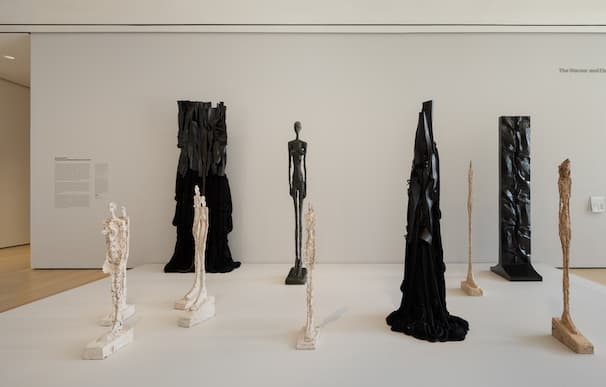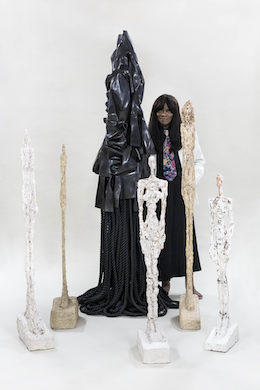The Giacometti Portion of This ‘Encounter’ Alone Is Worth It
His 1956 series titled ‘Femmes de Venise’ is being exhibited in America for the first time at the Museum of Modern Art in tandem with the work of Barbara Chase-Riboud.

One of the heartening aspects of the Museum of Modern Art’s recently opened exhibition “The Encounter: Barbara Chase-Riboud/Alberto Giacometti” is that it offers concrete proof of the existence of museum professionals who care about art.
You would think that might be a requirement of their jobs, but one dirty little not-so-secret of our cultural classes is how many of them don’t much care for, you know, culture. The objects curators have been tasked to care for are increasingly presented to audiences as irredeemable souvenirs of this, that, or the other sociological ill. You mean to say they aren’t glories of human endeavor? Don’t be naive.
That a painting or sculpture is the product of a specific place, time, and person is, of course, an inescapable fact. Yet works of art — that is to say, good works of art — are nothing if they don’t transcend their contexts. In doing so, the pieces tell us more about life on this planet than anyone, including the artist, could have intended. Art is complicated; aesthetic experience, freeing. That’s why puritans, autocrats, and Hannah Gadsby fear it.
But listen to this: “Sculpture as a created object in space should enrich, not reflect, and should be beautiful. Beauty is its function.” Say that again, please: Beauty is its function.
These are the words of Barbara Chase-Riboud and it’s to the good graces of MOMA’s Christophe Cherix; the Robert Lehman Foundation chief curator of drawings and prints, Emilie Bouvard at the Fondation Giacometti, Paris; and curatorial assistant Danielle Johnson that they highlight Ms. Chase-Riboud’s unapologetic avowal of aesthetic purpose. For those not familiar with the octogenarian Jacquette-of-all-trades, Ms. Chase-Riboud has more than a few accomplishments up her sleeve.

Born at Philadelphia to a scientist mother and a father who worked construction, she exhibited a knack for art at an early age. After attending the Tyler School of Art and Architecture, Ms. Chase-Riboud won a fellowship to the American Academy in Rome and received an M.F.A. from Yale University — the first African-American woman to do so. She’s garnered a host of awards, written poetry, and is the author of several novels, including “Sally Hemings” (1979), a book that did much to bring the title character to popular attention.
Among the most significant experiences of Ms. Chase-Riboud’s artistic life occurred after the 23-year-old artist left New Haven and went to Paris — that is to say, when she visited Alberto Giacometti in his studio. The sculptor, Ms. Chase-Riboud recounts, “was a walking Egyptian mummy, entirely white, covered in white plaster from his shoes to the Afro curly hair on his head.” Like the Swiss-born artist, she adopted the City of Light as her home.
“The Encounter” pairs several of Ms. Chase-Riboud’s effigies with those of Giacometti, who is represented by, among much else, a quintet of plaster pieces from a 1956 series titled “Femmes de Venise.” That this body of work has never before been exhibited in the United States is reason alone to make the exhibition a must-see for any New Yorker with an abiding interest in 20th century art. Even those who prefer Giacometti the painter to Giacometti the sculptor — the latter of whom can, let’s face it, get a mite lugubrious in his affectations — will find much to relish in their rough-hewn immediacy.
Both Ms. Chase-Riboud and Giacometti share an abiding fascination with the art of ancient Egypt. It’s there to glean in their hieratic emphasis on streamlined forms, emphatic contours, and a gravitas that hearkens to the funereal without altogether capitulating to it. Ms. Chase-Riboud’s bronzes present themselves very differently than those of Giacometti: They claim space whereas the “Femmes de Venise” are winnowed by it. Giacometti abjured the monolithic; Ms. Chase-Riboud confirms it.
Very much like Giacometti, though, Ms. Chase-Riboud iterates and intensifies the role of gravity in her art. If a base isn’t made an integral component of the work, as in “Woman’s Monument” (1998), then forms are defined — one might say “burdened” — by their physicality. In “Zanzibar” (1974), Ms. Chase-Riboud juxtaposes a compressed mass of bronze with a cluster of braided woolen cords. The corresponding discordance in texture manages to be singularly elegant even as it portends something both somber and severe.
The curators posit the exhibition as a reciprocal gesture on Ms. Chase-Riboud’s part to Giacometti’s invitation lo those many years ago. Grace and gratitude, in other words, are currently in evidence at MoMA. Given that those two benisons are forever in short supply, “The Encounter” is a welcome enterprise.

